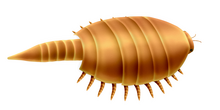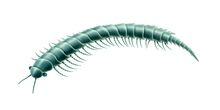Euthycarcinoidea
| Euthycarcinoidea Temporal range: | |
|---|---|

| |
| Life restoration of Apankura | |

| |
| Life restoration of Sottyxerxes | |
| Scientific classification | |
| Domain: | Eukaryota |
| Kingdom: | Animalia |
| Phylum: | Arthropoda |
| Clade: | Mandibulata |
| Subclass: | †Euthycarcinoidea Gall & Grauvogel, 1964 |
| Order: | †Euthycarcinida Gall & Grauvogel, 1964 |
| Genera | |
|
See text | |
Euthycarcinoidea are an enigmatic group of extinct, possibly amphibious arthropods that ranged from Cambrian to Triassic times. Fossils are known from Europe, North America, Argentina, Australia, and Antarctica.
Description
The euthycarcinoid body was divided into a cephalon (head), preabdomen, and postabdomen. The cephalon consisted of two segments and included mandibles, antennae and presumed eyes. The preabdomen consisted of five to fourteen tergites, each having up to three somites. Each somite had in turn a pair of uniramous, segmented legs. The postabdomen was limbless and consisted of up to six segments and a terminal tail spine.[1]
Affinities
Due to its particular combination of characteristics, the position of the Euthycarcinoidea within the Arthropoda has been ambiguous; previous authors have allied euthycarcinoids with crustaceans (interpreted as copepods, branchiopods, or an independent group), with trilobites, or the merostomatans (horseshoe crabs and sea scorpions, now an obsolete group[2]).[3] However, due to the general features and the discovery of fossils from this group in Cambrian rocks, a 2010 study suggested that they may have given rise to the mandibulates, the group that includes the myriapods (centipedes, millipedes and the like), crustaceans, and hexapods (insects, etc.).[4]
However, a 2020 study identified several characters, including compound eyes and various details of the preoral chamber, that suggested instead a position as the closest relatives of living myriapods.[5] This would help to close the gap between the earliest body fossils of crown-group myriapods in the Silurian and molecular clock data suggesting a divergence from their closest relatives during the Ediacaran or Cambrian.[1] This had already been suggested by the cladogram of a previous study.[6]
| |||||||||||||||||||

Environment and life habits
Euthycarcinoid fossils have been found in marine, brackish and freshwater deposits.[8] Taxa from the Cambrian are from marine or intertidal sediments, while all specimens from the Ordovician to the Triassic are freshwater or brackish.[3] Fossil impressions of euthycarcinoid postabdomens in association with Protichnites trackways in Cambrian intertidal/supratidal deposits also suggest that euthycarcinoids may have been the first arthropods to walk on land.[9][10] It has been suggested that the biofilms and microbial mats that covered much of the vast tidal flats during the Cambrian Period in North America may have provided the nourishment that lured these arthropods onto the land.[11] Fossil evidence also suggests the possibility that some euthycarcinoids came onto the land to lay and fertilize their eggs via amplexus, as do the modern horseshoe crabs.[12]
Classification
The known species of euthycarcinoids and their distribution were reviewed by Racheboeuf et al. in 2008. Additional species were described by Collette and Hagadorn in 2010.[3][9]
- Antarcticarcinus
- Antarcticarcinus pagoda Pagoda Formation Antarctica, Upper Carboniferous to Lower Permian.[13]
- Apankura machu (Cambrian), from marine deposits in Argentina
- Euthycarcinus
- Euthycarcinus ibbenburensis (Pennsylvanian: Westphalian), from freshwater deposits in Germany
- Euthycarcinus martensi (Permian), from freshwater deposits in Germany
- Euthycarcinus kessleri (Triassic), from freshwater deposits in France
- Mosineia macnaughtoni (Cambrian), from intertidal deposits in the United States
- Mictomerus melochevillensis (Cambrian), from intertidal deposits in Canada
- Pieckoxerxes pieckoae (Pennsylvanian: Westphalian), from brackish to freshwater deposits of the United States
- Synaustrus brookvalensis (Triassic) from freshwater deposits of Australia
- Ericixerxes potii (Upper Devonian) from brackish deposits in Belgium
Family Kottixerxidae Starobogatov, 1988
- Heterocrania rhyniensis (Lower Devonian), from freshwater deposits of the United Kingdom
- Kalbarria brimmellae (Ordovician or Late Silurian), from freshwater deposits of Australia (Age and habitat are controversial[14])
- Kottixerxes
- Kottixerxes anglicus (Pennsylvanian: Westphalian), from brackish to freshwater deposits of the United Kingdom
- Kottyxerxes gloriosus (Pennsylvanian: Westphalian), from brackish to freshwater deposits of the United States
- Schramixerxes gerem (Late Pennsylvanian: Stephanian stage), from freshwater deposits in France
- Smithixerxes
- Smithixerxes juliarum (Pennsylvanian: Westphalian), from brackish to freshwater deposits of the United States
- Smithixerxes pustulosus (Pennsylvanian: Westphalian), from brackish to freshwater deposits of the United Kingdom
- Sottyxerxes multiplex (Late Pennsylvanian: Stephanian stage), from freshwater deposits in France
References
- ^ a b Ortega-Hernández et al. (2010), p. 195
- ^ Lamsdell, James C. (2012-12-18). "Revised systematics of Palaeozoic 'horseshoe crabs' and the myth of monophyletic Xiphosura". Zoological Journal of the Linnean Society. 167 (1): 1–27. doi:10.1111/j.1096-3642.2012.00874.x. ISSN 0024-4082.
- ^ a b c Racheboeuf et al. (2008)
- ^ Ortega-Hernández et al. (2010), p. 196
- ^ Edgecombe, Gregory D.; Strullu-Derrien, Christine; Góral, Tomasz; Hetherington, Alexander J.; Thompson, Christine; Koch, Marcus (2020). "Aquatic stem group myriapods close a gap between molecular divergence dates and terrestrial fossil record". Proceedings of the National Academy of Sciences. 117 (16): 8966–8972. doi:10.1073/pnas.1920733117. PMC 7183169. PMID 32253305. S2CID 215408474.
- ^ Vannier, Jean; Aria, Cédric; Taylor, Rod S.; Caron, Jean-Bernard (June 2018). "Waptia fieldensis Walcott, a mandibulate arthropod from the middle Cambrian Burgess Shale". Royal Society Open Science. 5 (6): 172206. doi:10.1098/rsos.172206. ISSN 2054-5703. PMC 6030330. PMID 30110460.
- ^ McNamara & Trewin (1993)
- ^ Ortega-Hernández et al. (2010), pp. 196–197
- ^ a b Collette & Hagadorn (2010)
- ^ Collette, Gass & Hagadorn (2012)
- ^ MacNaughton et al. (2002), p. 394
- ^ Collette, Gass & Hagadorn (2012), pp. 452–453
- ^ Collette, Joseph H.; Isbell, John L.; Miller, Molly F. (September 2017). "A unique winged euthycarcinoid from the Permian of Antarctica". Journal of Paleontology. 91 (5): 987–993. doi:10.1017/jpa.2017.28. ISSN 0022-3360.
- ^ "Terrestrialization in the Ordovician". Geological Society, London, Special Publications. doi:10.1144/sp532-2022-92. Retrieved 2022-11-14.
Bibliography
- Anderson, Lyall I.; Trewin, Nigel H. (1991). "An early Devonian arthropod fauna from the Windyfield cherts, Aberdeenshire, Scotland". Palaeontology. 46 (3): 467–509. doi:10.1111/1475-4983.00308.
- Collette, Joseph H.; Gass, Kenneth C.; Hagadorn, James W. (2012). "Protichnites eremita unshelled? Experimental model-based neoichnology and new evidence for a euthycarcinoid affinity for this ichnospecies". Journal of Paleontology. 86 (3): 442–454. doi:10.1666/11-056.1. S2CID 129234373.
- Collette, Joseph H.; Hagadorn, James W. (2010). "Three-dimensionally preserved arthropods from Cambrian Lagerstatten of Quebec and Wisconsin". Journal of Paleontology. 84 (4): 646–667. doi:10.1666/09-075.1. S2CID 130064618.
- MacNaughton, Robert B.; Cole, Jennifer M.; Dalrymple, Robert W.; Braddy, Simon J.; Briggs, Derek E. G.; Lukie, Terrence D. (2002). "First steps on land: Arthropod trackways in Cambrian–Ordovician eolian sandstone, southeastern Ontario, Canada". Geology. 30 (5): 391–394. Bibcode:2002Geo....30..391M. doi:10.1130/0091-7613(2002)030<0391:FSOLAT>2.0.CO;2. S2CID 130821454.
- McNamara, Kenneth J.; Trewin, Nigel H. (1993). "A euthycarcinoid arthropod from the Silurian of Western Australia". Palaeontology. 36: 319–335.
- Ortega-Hernández, Javier; Legg, David A.; Tremewan, Jonathan; Braddy, Simon J. (2010). "Euthycarcinoids". Geology Today. 26 (5): 195–198. doi:10.1111/j.1365-2451.2010.00770.x.
- Racheboeuf, Patrick R.; Vannier, Jean; Schram, Frederick R.; Chabard, Dominique; Sotty, Daniel (2008). "The euthycarcinoid arthropods from Montceau-les-Mines, France: functional morphology and affinities" (PDF). Earth and Environmental Science Transactions of the Royal Society of Edinburgh. 99 (1): 11–25. doi:10.1017/S1755691008006130. S2CID 59123727.
- Vaccari, N. E.; Edgecome, G. D.; Escudero, C. (2004). "Cambrian origins and affinities of an enigmatic fossil group of arthropods". Nature. 430 (6999): 554–557. Bibcode:2004Natur.430..554V. doi:10.1038/nature02705. PMID 15282604. S2CID 4419235.
